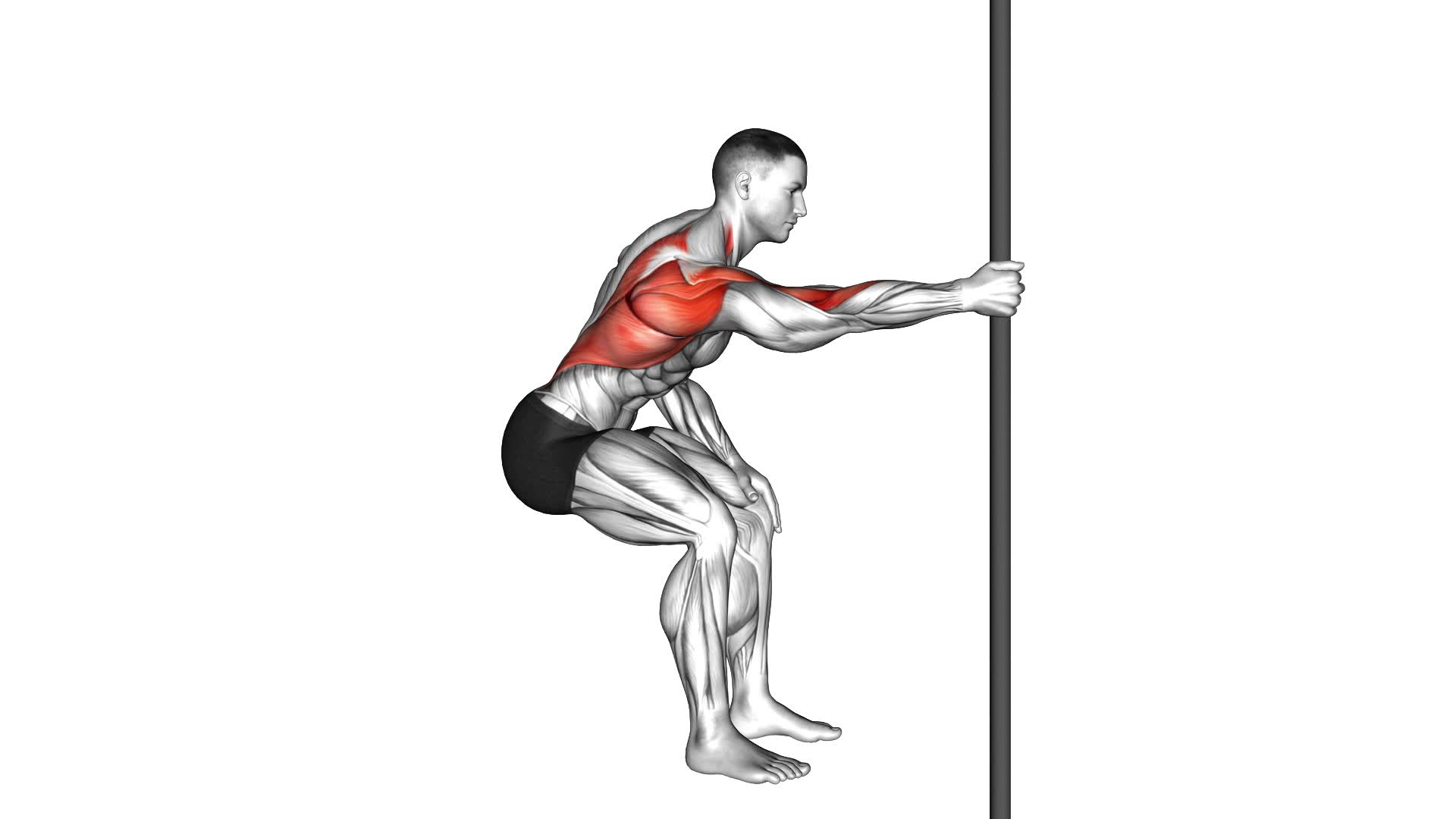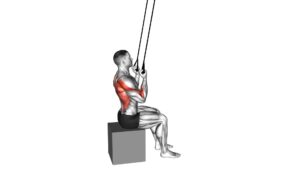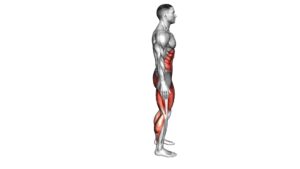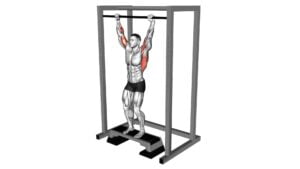Fixed Bar Back Stretch – Video Exercise Guide & Tips

Are you looking for a simple and effective way to stretch your back? Look no further than the fixed bar back stretch!
Watch This Exercise Video
This exercise targets your back muscles and can help improve flexibility and relieve tension.
In this article, we'll provide you with a video exercise guide and valuable tips to ensure you're performing the stretch correctly.
Get ready to maximize the benefits of this stretch and avoid common mistakes.
Let's dive in and get started!
Key Takeaways
- The fixed bar back stretch improves flexibility, posture, and range of motion in joints and muscles.
- It targets back muscles such as the latissimus dorsi and erector spinae, alleviating tension and tightness in the back.
- Proper form and technique are important, including finding the right height bar and using a bar that allows for a full stretch.
- Breathing deeply and coordinating breathing with the movement of the stretch can maximize the effectiveness of the exercise.
Benefits of the Fixed Bar Back Stretch
To fully understand the benefits of the Fixed Bar Back Stretch, it's important for you to know how this exercise can improve your flexibility and posture. Stretching is crucial for overall flexibility, as it helps to increase the range of motion in your joints and muscles. By incorporating the fixed bar back stretch into your daily stretching routine, you can further enhance your flexibility and promote better posture.
The fixed bar back stretch specifically targets the muscles in your back, including the latissimus dorsi and the erector spinae. These muscles play a vital role in maintaining proper posture and preventing back pain. By stretching and lengthening these muscles, you can alleviate tension and tightness, which often contribute to poor posture.
To incorporate the fixed bar back stretch into your daily routine, start by finding a sturdy fixed bar that's at a height where you can comfortably hang from it with your feet off the ground. Grab the bar with an overhand grip and hang down, allowing your body to fully relax. Hold the stretch for 30 seconds to a minute, focusing on breathing deeply and releasing any tension in your back.
Proper Form and Technique for the Stretch
To perform the fixed bar back stretch with proper form and technique, you should begin by finding a sturdy fixed bar at a height where you can comfortably hang from it with your feet off the ground. This exercise can be done at the gym or even at home if you have the right equipment.
One common misconception is that you need a lot of upper body strength to do this stretch. While some strength is required, the main focus of the exercise is on stretching and lengthening the muscles in your back and shoulders.
As for equipment, all you really need is a sturdy fixed bar that can support your body weight. Make sure to find a bar that's at a height where you can hang freely without your feet touching the ground. This will allow for a full and effective stretch.
Now that you know the proper form and equipment needed for the fixed bar back stretch, let's move on to some tips for maximizing the effectiveness of the stretch.
Tips for Maximizing the Effectiveness of the Stretch
Maximize the effectiveness of the stretch by incorporating proper breathing techniques. Here are some tips to help you get the most out of your fixed bar back stretch:
- Breathe deeply: Take slow, deep breaths as you perform the stretch. Inhale deeply through your nose and exhale through your mouth. This helps to relax your body and increase flexibility.
- Focus on the exhale: As you reach your maximum stretch position, focus on exhaling fully. This helps to release tension and allows you to sink deeper into the stretch.
- Maintain a steady rhythm: Coordinate your breathing with the movement of the stretch. Inhale as you prepare to stretch and exhale as you move into the stretch. This rhythmic breathing can enhance your body's response to the stretch.
- Recommended duration: Hold the fixed bar back stretch for 20 to 30 seconds. This allows your muscles to fully relax and elongate. Remember to continue breathing deeply throughout the entire duration of the stretch.
By incorporating proper breathing techniques and following the recommended duration, you can maximize the effectiveness of the fixed bar back stretch.
Now, let's move on to the next section and discuss the common mistakes to avoid during this stretch.
Common Mistakes to Avoid During the Fixed Bar Back Stretch
To get the most out of your fixed bar back stretch, it's important to be aware of common mistakes to avoid. Proper form is essential to prevent injury and ensure the effectiveness of the stretch.
One common mistake is rounding your back instead of maintaining a straight spine. This not only reduces the stretch's effectiveness but also puts unnecessary strain on your lower back.
Another mistake is pulling too hard on the bar, which can lead to overstretching and potential muscle tears. It's important to use a gentle and controlled force while performing the stretch.
Additionally, gripping the bar too tightly can cause tension in your forearms and wrists, detracting from the intended focus on your back muscles. Remember to maintain a relaxed grip to avoid unnecessary strain.
Lastly, avoid arching your neck backward, as this can strain your cervical spine. Instead, keep your neck in a neutral position throughout the stretch.
Variations and Modifications for Different Fitness Levels
If you're looking to modify the fixed bar back stretch for different fitness levels, consider incorporating variations that cater to individual needs.
Here are some progression options and equipment modifications to help you tailor the exercise:
- Use a lower bar: If you're a beginner or have limited flexibility, start by using a lower bar. This will reduce the intensity of the stretch and allow you to gradually progress over time.
- Adjust hand placement: Depending on your fitness level, you can experiment with different hand placements on the bar. Widening or narrowing your grip can target different areas of the back and shoulders.
- Add resistance: Once you have mastered the basic fixed bar back stretch, you can increase the challenge by adding resistance. This can be done by using resistance bands or attaching weights to your body.
- Incorporate dynamic movements: For more advanced individuals, you can incorporate dynamic movements into the stretch. This can include swinging or twisting motions to increase the range of motion and engage more muscles.
Remember to listen to your body and gradually progress as your fitness level improves. By incorporating these variations and modifications, you can make the fixed bar back stretch suitable for individuals of all fitness levels.
Frequently Asked Questions
How Often Should I Perform the Fixed Bar Back Stretch?
To get the most out of the fixed bar back stretch, it's important to know how often to perform it.
The frequency of this exercise depends on your goals and current fitness level. Generally, it's recommended to do the fixed bar back stretch 2-3 times a week.
This will help improve flexibility in your back, relieve tension, and promote better posture.
Consistency is key, so make sure to incorporate this stretch into your regular routine for maximum benefits.
Can the Fixed Bar Back Stretch Help Alleviate Lower Back Pain?
The fixed bar back stretch is a great exercise for alleviating lower back pain. By regularly performing this stretch, you can experience the benefits of improved flexibility and reduced tension in your lower back muscles.
The proper form for the fixed bar back stretch involves hanging from a fixed bar and allowing your body to naturally elongate and decompress the spine. This stretch is a safe and effective way to target and relieve lower back pain.
Is It Safe to Perform the Fixed Bar Back Stretch if I Have a Previous Back Injury?
If you have a previous back injury, it's important to take certain precautions when performing the fixed bar back stretch. Consult with a healthcare professional before attempting this exercise. They can provide guidance on how to modify the stretch to ensure it's safe and appropriate for your condition.
Always listen to your body and stop immediately if you experience any pain or discomfort. Prioritizing safety and proper form is crucial when dealing with a back injury.
Can the Fixed Bar Back Stretch Improve My Posture?
Improving your posture is a common goal, and the fixed bar back stretch can help you achieve it.
This exercise targets the muscles in your back, shoulders, and chest, which play a crucial role in maintaining proper posture.
By regularly performing the fixed bar back stretch, you can strengthen these muscles and promote better alignment of your spine.
To enhance the effectiveness of this stretch, focus on maintaining proper form, engaging your core, and gradually increasing the intensity over time.
Are There Any Alternatives to the Fixed Bar Back Stretch That Target the Same Muscle Groups?
If you're looking for alternative exercises that target the same muscle groups as the fixed bar back stretch, there are a few options you can try.
One alternative is the standing cat-camel stretch, which helps to improve posture and flexibility in the back.
Another option is the seated spinal twist, which stretches the muscles along the sides of the back.
Both of these exercises can provide similar benefits to the fixed bar back stretch.
Conclusion
In conclusion, the fixed bar back stretch is a beneficial exercise that can help improve flexibility and relieve tension in the back muscles.
By maintaining proper form and technique, and following the tips provided, you can maximize the effectiveness of this stretch.
It's important to avoid common mistakes and to remember that there are variations and modifications available to accommodate different fitness levels.
Incorporating the fixed bar back stretch into your routine can contribute to a healthier and more flexible back.

Author
Years ago, the spark of my life’s passion ignited in my mind the moment I stepped into the local gym for the first time. The inaugural bead of perspiration, the initial endeavor, the very first surge of endorphins, and a sense of pride that washed over me post-workout marked the beginning of my deep-seated interest in strength sports, fitness, and sports nutrition. This very curiosity blossomed rapidly into a profound fascination, propelling me to earn a Master’s degree in Physical Education from the Academy of Physical Education in Krakow, followed by a Sports Manager diploma from the Jagiellonian University. My journey of growth led me to gain more specialized qualifications, such as being a certified personal trainer with a focus on sports dietetics, a lifeguard, and an instructor for wellness and corrective gymnastics. Theoretical knowledge paired seamlessly with practical experience, reinforcing my belief that the transformation of individuals under my guidance was also a reflection of my personal growth. This belief holds true even today. Each day, I strive to push the boundaries and explore new realms. These realms gently elevate me to greater heights. The unique combination of passion for my field and the continuous quest for growth fuels my drive to break new ground.







